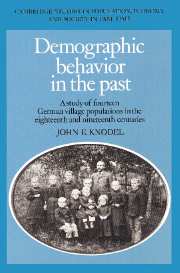 Demographic Behavior in the Past
Demographic Behavior in the Past Published online by Cambridge University Press: 04 August 2010
European historical demography was revolutionized in the 1950s by the pioneering analyses of Louis Henry using data assembled through the technique of family reconstitution. The technique involves a process through which individual records of births, deaths, and marriages (or baptisms, burials, and weddings) contained in parish registers are linked together into histories of vital events for individual families. The resultant micro-level set of linked information permits a far greater depth of analysis than is possible through earlier conventional approaches utilizing parish registers.
The earlier techniques relied primarily on simple aggregative counts of vital events. Thus the information available to the analyst was typically limited to annual or monthly time series of births, deaths, and marriages. These were used primarily to examine short-term fluctuations and their interrelationships. However, there was usually no basis to calculate demographic rates because, given the rarity and imperfections of census-like documents for much of the period covered by parish records, counts of the population at risk were generally unknown. Among other things, this seriously hampered longer-range comparisons. To put it simply, traditional aggregative counting techniques provided information on the flow of events but not the stock that gave rise to them.
The strengths of family reconstitution
Since family reconstitution establishes linkages between events happening to the same individual, or to members of the same family, far more demographic information is available for an individual or family than would otherwise be the case.
To save this book to your Kindle, first ensure [email protected] is added to your Approved Personal Document E-mail List under your Personal Document Settings on the Manage Your Content and Devices page of your Amazon account. Then enter the ‘name’ part of your Kindle email address below. Find out more about saving to your Kindle.
Note you can select to save to either the @free.kindle.com or @kindle.com variations. ‘@free.kindle.com’ emails are free but can only be saved to your device when it is connected to wi-fi. ‘@kindle.com’ emails can be delivered even when you are not connected to wi-fi, but note that service fees apply.
Find out more about the Kindle Personal Document Service.
To save content items to your account, please confirm that you agree to abide by our usage policies. If this is the first time you use this feature, you will be asked to authorise Cambridge Core to connect with your account. Find out more about saving content to Dropbox.
To save content items to your account, please confirm that you agree to abide by our usage policies. If this is the first time you use this feature, you will be asked to authorise Cambridge Core to connect with your account. Find out more about saving content to Google Drive.